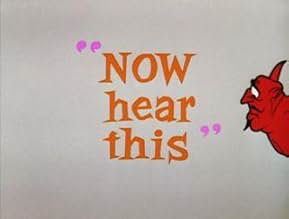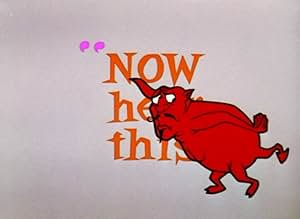In this very abstract cartoon, a hard-of-hearing old Britisher finds a red horn and uses it as a megaphone, unaware that it is really a lost horn from the Devil's forehead. The Britisher fin... Read allIn this very abstract cartoon, a hard-of-hearing old Britisher finds a red horn and uses it as a megaphone, unaware that it is really a lost horn from the Devil's forehead. The Britisher finds that the horn has the effect of amplifying every sound psychedelically and causing him ... Read allIn this very abstract cartoon, a hard-of-hearing old Britisher finds a red horn and uses it as a megaphone, unaware that it is really a lost horn from the Devil's forehead. The Britisher finds that the horn has the effect of amplifying every sound psychedelically and causing him serious bodily harm.
- Directors
- Writers
- Star
- Nominated for 1 Oscar
- 1 nomination total
- Vocal effects
- (voice)
- (uncredited)
- Directors
- Writers
- All cast & crew
- Production, box office & more at IMDbPro
Featured reviews
The basic premise follows an elderly British man who mistakes one of Satan's horns as an ear trumpet and proceeds to fall into hijinks and chaos. With the right comedic timing and all the sound effects courtesy of legendary LT editor Treg Brown, this short could easily be a delight throughout. Unfortunately, what bogs it all down is how sluggish and labored the pacing becomes, making a lot of the surprises feel more off putting than funny. Outside of the variety of sound effects which do at least convey a lot in how they're utilized, much of the humor is executed through eye popping pop art, making the short feel too dated for its own good. As a result, much of what happens as a result of the hellish horn feels as made up as it goes along, with the so-called wacky nonsense feeling all over the place. Unlike any other cartoon where you empathize with the unfortunate victim in this circumstance while also being entertained by all the inventive trickery on screen, the short makes you feel sorry for the old man and wish he could get out of this nightmarish predicament.
If there is one notable quality that does actually pay off in the cartoon's favor, at least controversial musical composer William Lava made the most with the material. Lava's work in the later WB cartoons paled in comparison to the likes of Carl Stalling and Milt Franklyn as his trademark style favored experimental cutting edge tracks over classic vaudeville or jazzy bands. That being said, as this short goes all over the place in its execution, it actually allows for a lot of free range in the usage of musical instruments, conveying the tone a lot better than any of the writing or animation does. As mechanical and alienesque as Lava's work tended to sound in the later WB shorts, this one fully displayed his talent through careful planning and pay off. Also, the pantomime acting Chuck Jones was known for in a lot of his best work like Feed the Kitty and Mouse Warming lends itself well in how much emotional turmoil the old man is going through. Even at a time when the UPA influence in animation was still at play, albeit not so effectively, Jones was still able to lend his solid tropes well.
So despite an interesting concept and some fine details sprinkled throughout, Now Hear This fails as an experimental piece by indulging too much in its minimal grandeur. It should go without saying that while any animated short film has the right to go outside what is expected from casual viewers, it should at least understand what it's trying to accomplish while entertaining whoever is interested in it. If it's supposed to be for a niche market, it should at least know what is to be expected in the long run. Perhaps recommending this short is up to whoever lies in that type of field.
What's the point of the cartoon? Why ask? This cartoon has as its purpose total abstraction, and it achieves that. "Now Hear This" certainly deserved its Oscar nomination (too bad that Chuck didn't win more during his lifetime). As the cartoon's not readily available on video or DVD, you can watch it on YouTube.
Did you know
- TriviaThis was the first Warner Bros cartoon to use the "modern" Looney Tunes opening and closing sequence featuring stylized animation, an abstract WB logo, zooming "OO" in the word "Cartoon", swirling zooming lines (in place of the zooming shield), and slick lettering, on a black background, all to a "modern" rendition of the Looney Tunes theme ("The Merry-Go-Round Broke Down"). This title will also be used on four 1964 shorts ("Bartholomew Vs. The Wheel," "Senorella and the Glass Huarache," "Pancho's Hideaway" and "Road to Andalay,) and then every WB cartoon from 1965 to 1969.
- Quotes
[the only spoken line]
Voice: QUIET!
- ConnectionsEdited from Knights Must Fall (1949)
Details
- Runtime6 minutes
- Sound mix
- Aspect ratio
- 1.37 : 1
Contribute to this page

















